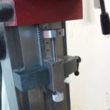Home : Workshop : Metalwork : Mini Mill :
 Blind hole drilling/reaming/tapping had me wanting an easy way to set cutting depths relative to the top of the material. Being able to easily adjust/(re)set milling depths was a bonus (I haven't used the z-axis knob since installing this). As is, the stop has a range of ~38mm/1-1/2" and can be adjusted in 1mm (full turn, setscrew facing forward) to .1mm (~.004") per facet increments (.05mm if you count the smaller facets).
Blind hole drilling/reaming/tapping had me wanting an easy way to set cutting depths relative to the top of the material. Being able to easily adjust/(re)set milling depths was a bonus (I haven't used the z-axis knob since installing this). As is, the stop has a range of ~38mm/1-1/2" and can be adjusted in 1mm (full turn, setscrew facing forward) to .1mm (~.004") per facet increments (.05mm if you count the smaller facets).
The top of the m6 x 1mm adjusting rod is a decagon (1mm/10=.1mm per facet) milled from 1-1/8" cold rolled rod on a spin indexer. The rod passes though a threaded C shape milled piece of 3/4 square cold rolled that is held to the stock stop with two m4 setscrews. There is a nylon thumb screw on the side to keep the rod from vibrating out of position. There is also a steel rule screwed to the back of the C with two m3 screws.
With the stop set at a multiple of 10mm, a quick/rough stop height can be set by using the ruler to visually set the stop a measured distance from the head. When accuracy is required, I touch the bit against the stock and slide/set the stop up against the head. The stop can then be turned to accurately cut anything from a couple thousandths to whatever. The knurled aluminum cap on the bottom of the rod easily spins the weighted (decagon) rod when setting deep cuts.
I have a 1/4-20 threaded mounting block that could be finished out with an inch scale and 10 facet (.005" per) stop if anyone is interested in purchasing it.
Depth Stop
 Blind hole drilling/reaming/tapping had me wanting an easy way to set cutting depths relative to the top of the material. Being able to easily adjust/(re)set milling depths was a bonus (I haven't used the z-axis knob since installing this). As is, the stop has a range of ~38mm/1-1/2" and can be adjusted in 1mm (full turn, setscrew facing forward) to .1mm (~.004") per facet increments (.05mm if you count the smaller facets).
Blind hole drilling/reaming/tapping had me wanting an easy way to set cutting depths relative to the top of the material. Being able to easily adjust/(re)set milling depths was a bonus (I haven't used the z-axis knob since installing this). As is, the stop has a range of ~38mm/1-1/2" and can be adjusted in 1mm (full turn, setscrew facing forward) to .1mm (~.004") per facet increments (.05mm if you count the smaller facets).The top of the m6 x 1mm adjusting rod is a decagon (1mm/10=.1mm per facet) milled from 1-1/8" cold rolled rod on a spin indexer. The rod passes though a threaded C shape milled piece of 3/4 square cold rolled that is held to the stock stop with two m4 setscrews. There is a nylon thumb screw on the side to keep the rod from vibrating out of position. There is also a steel rule screwed to the back of the C with two m3 screws.
With the stop set at a multiple of 10mm, a quick/rough stop height can be set by using the ruler to visually set the stop a measured distance from the head. When accuracy is required, I touch the bit against the stock and slide/set the stop up against the head. The stop can then be turned to accurately cut anything from a couple thousandths to whatever. The knurled aluminum cap on the bottom of the rod easily spins the weighted (decagon) rod when setting deep cuts.
I have a 1/4-20 threaded mounting block that could be finished out with an inch scale and 10 facet (.005" per) stop if anyone is interested in purchasing it.
